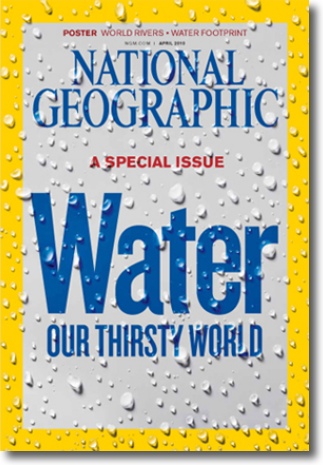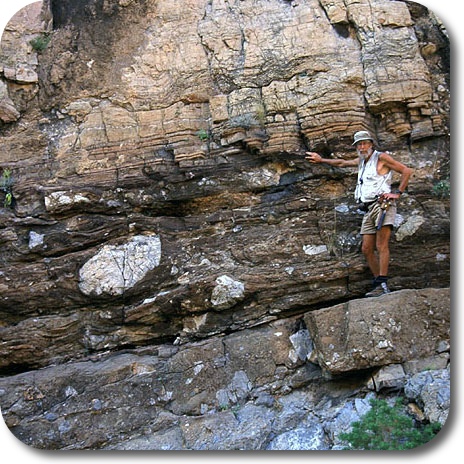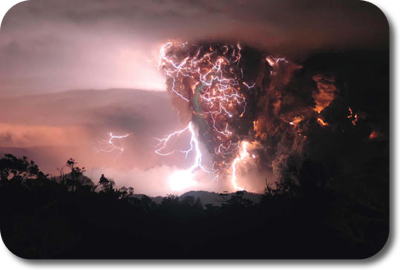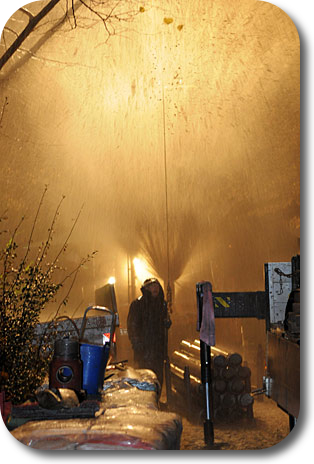Archive for the ‘Water in the Media’ tag
World Water Day – National Geographic Special Edition on Water
March 22nd was “World Water Day“. This day gave reason for National Geographic to devote a full issue to the topic of Water. Even more, they let you explore this issue online, for free, and with a few extras such as interactive maps and background stories. It really is a nicely done interactive version, taking advantage of browsing, searching, video and audio. The only unfortunate thing is that it is based on flash.

Cover page of the April 2010 issue of the US National Geographic
For the same occasion, world water day, boston.com has a water-themed collection of astonishing photographs in their “The Big Picture” category
Friday News: AGU; on Science News on Science Blogs;
Hi folks, here are some of the thoughts that came to my mind over the last few days.
AGU — looking back
The AGU fall meeting happened a couple of weeks ago now. However, it’s still vividly in my mind and there are still thoughts popping up:
it was such a big meeting, so that it was impossible to see or hear everything. Hence it is a great thing for the people who attended the meeting, as well as for people who did not, that some of the lectures are available online. Here is a great example, the online version of of a presentation, the Bjerkens Lecture, given by Richard B. Alley from Penn State University. As it happens, the best live talk I have attended at the meeting was also by Richard B. Alley, when he talked about flying buttresses and ice shelves. The Bjerkens Lecture is on the role of CO2 in earth’s history. Here are a few of my thoughts:
for times when there are no more ice cores available, those earth scientists (that is the climate-earth-scientists as opposed to “us hydrogeologists”) need to do the same thing as we do — look for other sources of data that help them to infer what they were looking for in the first place. One example that Alley presents is that they look for the density of openings in ancient leafs. Leaves “have to decide” if they put many holes in their leaves, which allows them to take in a lot of CO2 which they need for breathing, but which also dries them out quicker – or if they put few holes in their leaves, allowing little CO2 to come in but at the same time allowing only little water to go out. If the atmosphere contains little CO2, plants need relatively more holes in their leaves. I think this is a great example of “complimentary independent data-sets“, a term coined by John Cherry. Call me a geek, but I do like this term!
Alley mentions snowball earth, and there is also a cool picture in his talk from Namibia, which can be found here

Boulders dropped by icebergs into laminated marine sediment in late Precambrian time, Narachaampspos, Kaokoveld, Namibia. The chief proponent of the Snowball Earth hypothesis, Paul Hoffman, points to the transition to carbonate rocks which indicate the sudden termination of this frigid event. Photo M. J. Hambrey.
- Alley mentions very briefly something along the lines that the mid-range models are right. Well, I don’t think that’s surprising. I would argue that the more important question is, if the extreme models get the extremes right…
There are two other blog-posts related to AGU which I want to point out:
Brian Shiro wrote a nice agu-summary on his blog “astronaut for hire”
Dana MacKenzie wrote a nice post about the AGU’s “geoblogger meet-up” — there were some interesting and inspiring people, indeed!
Soil in the News
Two sites, “ScienceDaily” and “ScienceBlog” have the exact same story today, with exact the same heading: “Water hits and sticks: Findings challenge a century of assumptions about soil hydrology”. That sounds quite intriguing. Both articles stat that the research they write about is published on Nature Geoscience, but neither link to the paper. It is here. The “paper” is actually called in Nature Geoscience lingo a “letter”, and I am not sure what that implies.
Here is how I picture the process: it rains, some water enters the soil below the root zone, it continues it’s path towards the water table, some might flow laterally (towards a stream), some other part might be perched, and finally the rest makes it to the water table. On its way to the water table, it is commonly assumed, as the authors point out, that “water entering the soil as precipitation displaces the water that was present previously, pushing it deeper into the soil and eventually into the stream”, a concept referred to as “translatory flow”. Here is my first complaint, as stated above, I don’t think all the water below the root zone must go straight into a stream. But I agree with the (so far commonly used) concept of displacement.
The authors collected isotopic data, which suggests that “a pool of tightly bound water that is retained in the soil and used by trees does not participate in translatory flow, mix with mobile water or enter the stream.” And I think this is the key finding of this letter. Some water of the process I described above, might stay very close to the root zone.
This finding makes the authors suggest that their implications “are perhaps most profound for biogeochemical cycling and transport of nutrients to streams”. At the same time the authors concede that
“(t)his conceptual framework requires further testing to see if the underlying mechanisms are true, and if such separation of water resources holds for different climates and locations.”
I am wondering, how these two blog posts in ScienceDaily and ScienceBlog actually happened. Who wrote them? With what intentions?
More Water-Related News
- WaterWired has put up a great list of “Well-Worn Water Words” in two parts (part 1, part 2). Here is my favourite:
Water is the new oil because whisky is for drinking and water is for fighting, unless you are already in a water war, in which case you are probably already in water-power nexus from which only integrating science and policy will begin to address the fish versus farmer conflict defeating all efforts toward sustainability.
Scott Long on NASW reports on a previously unknown toxin in treated water. This is intriguing, because during the process of trying to eliminate as many bad substances as possible, another and possible quite a few other bad substances are created. Even worse, probably not many people look for those “by-products”.
Waterlogged points to a new documentary about the global water crisis, called “Flow”. Waterlooged links to two videos in which Maude Barlow (author of Blue Gold
) and Amy Goodman (of Democracy Now) http://waterblogged.info/2008/03/02/new-water-crisis-documentary-flow-for-the-love-of-water/
Science Pictures

Chaiten volcano eruption
More spectacular science pictures, including a cow with a gas-tank on its back at popsci.com
Water is Beautiful!
Garbage in the Oceans
I have written in the past about garbage in the world’s oceans (here and here).
About a week ago, the New York Times has a story that is extremely moving in my opinion on that topic. In short, two thoughts just blow my mind:
- “the Pacific garbage patch, an area of widely dispersed trash that doubles in size every decade and is now believed to be roughly twice the size of Texas“.
- The biggest problem of the garbage is plastic: “… when a predator — a larger fish or a person — eats the fish that eats the plastic, that predator may be transferring toxins to its own tissues, and in greater concentrations since toxins from multiple food sources can accumulate in the body”.
Bohrunfall in Wiesbaden
Bei Bauarbeiten am Finanzministerium in Wiesbaden ist es zu einem spektakulären Unfall gekommen: unerwartet wurde ein gespannter Grundwasserleiter angebohrt. Das unter Druck stehende Wasser bahnte sich seinen Weg durch das Bohrloch nach oben, was in einer relativ imposanten Fontäne resultierte:

Das Wiesbadener Tagblatt berichtet hier und hier. Siehe auch Berichte in der Sueddeutschen und vom Hessischen Rundfunk. Interessant ist dass bei spaeteren Meldungen von einer “Wasserblase” die Rede ist, und nicht mehr von einem gespannten Grundwasserleiter.
Hier ist eine Fotostrecke.
Ist jemand vor Ort und kann Erfahrungen schildern?
Local Water News – Extreme Events!
The Stuttgarter Zeitung recently published two articles related to water:
The first article describes the flood-protection measures for a part of the city of Tübingen. The city council just agreed to start building a dam in 2010. This dam will be able to stand in a flood with a 20-year return period.
A normally relatively small creek, the “Goldersbach“, has lead in the past after extreme precipitation events to extensive flooding and related destruction. The dam is part of a multiple-level protection strategy, which is outlined in this publication. The dam is a good thing, however it won’t withstand any substantial floods, that is floods bigger than with a 20-year return period. This is why the warning time is critical for the citizens living in the area! The article states that the warning time is five hours. It would be interesting to get to know details on how they estimate five hours as the warning time. Measurements have to be made, submitted, and calculations and predictions have to be made, involving fair amounts of uncertainty.
The second article describes how NASA researchers found out while working with GRACE data that groundwater levels are declining in India since 2002, even though the precipitation patterns have been fairly normal.
These are two practical examples that illustrate how extreme events are critical and need special attention!
Bill Gates Seems to be Into a New “Toy”
The “New Orleans Metro Real-Time News” (and they know) reports on a new toy of Mr. Microsoft, Bill Gates. He wants to deploy “tubs” into the ocean in hurricane-prone areas, such as off the coast of New Orleans. These tubs are supposed to “harvest” the energy of hurricanes, convert this energy into electrical energy via a turbine, and hence decrease the amount of destruction of a hurricane when it hits land. Call me a sceptic, but somehow it seems to me, those tubs might be destroyed before they can harvest any energy…
TV Show on Water
The Bavarian TV statation (BR) is showing every sunday night a “mini-serie” entitled “The Thirsty Planet” at 9:15pm. The first two sequels on agricultural water use and water in big cities have been broadcasted already. On sunday the topic will be engineering works related to water, followed by economic aspects of water and finally a show attempting an outlook on how the water-situation will develop.
Enjoy the show!
Home
Yann Arthus-Bertrand, the guy who made the book Earth from Abovein 2005, just made a movie called “Home“.

It will be available online, for free, for one day on June 5th, for example on YouTube. Here is the trailer: